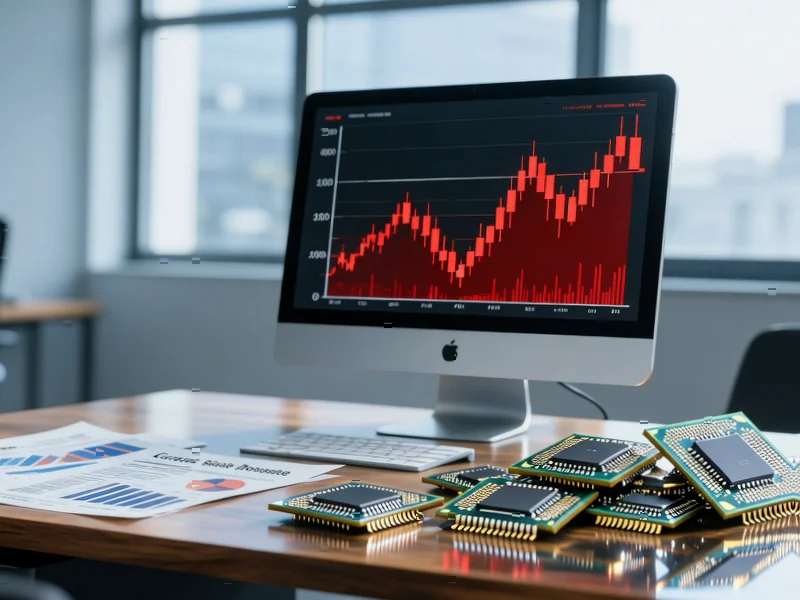According to Futurism, Nvidia recently became the first company in history to reach a $5 trillion market valuation just 78 days after hitting $4 trillion, fueled by massive AI investments driving US stocks to record highs. Among the 80 analysts covering Nvidia for Bloomberg terminals, 73 rate the stock as a “buy” while only six say “hold” and one, Seaport Global Securities senior analyst Jay Goldberg, maintains a “sell” rating. Goldberg, who lived through the dot-com bubble, warns that current AI spending patterns resemble that period’s excesses, with money being passed between tech corporations in “round-tripping” practices that could collapse if regulators intervene. He observes that despite AI’s potential, the technology has yet to generate substantial revenue compared to its massive costs, creating a bubble that could “tumble down” when spending inevitably stops. This contrarian perspective comes as we examine the structural risks in the AI investment landscape.
Table of Contents
- The Round-Tipping Risk That Could Unravel AI Spending
- Dot-Com Parallels: More Than Just Déjà Vu
- The Regulatory Sword of Damocles
- AI’s Productivity Paradox: Where’s the ROI?
- The Quiet Consensus Among Institutional Investors
- Nvidia’s Fundamental Scaling Problem
- Navigating the AI Investment Landscape
- Related Articles You May Find Interesting
The Round-Tipping Risk That Could Unravel AI Spending
Goldberg’s mention of round-tripping practices points to a deeper structural vulnerability in the AI ecosystem. When major cloud providers like Microsoft, Google, and Amazon purchase billions in Nvidia hardware, then sell AI services back to each other and to the same ecosystem of AI startups they’re funding, it creates a circular economy that can mask true end-market demand. This isn’t just theoretical – we’ve seen similar patterns in previous technology cycles where capital recycling between strategic partners created the illusion of sustainable growth. The concern is that much of this spending represents capacity building for anticipated demand that may never materialize at projected scales.
Dot-Com Parallels: More Than Just Déjà Vu
Having covered technology investing for over two decades, I see Goldberg’s dot-com comparison as more than just a convenient analogy. The late 1990s saw similar patterns where infrastructure companies like Cisco Systems reached valuations predicated on endless internet growth, only to collapse when the underlying demand failed to materialize. Nvidia’s current position as the essential picks-and-shovels provider for the AI gold rush mirrors Cisco’s role in the internet boom. What’s particularly concerning is the speed of this adoption cycle – while internet infrastructure built gradually over years, AI investment has compressed into quarters, potentially creating an even more dramatic correction when it comes.
The Regulatory Sword of Damocles
Goldberg’s warning about potential regulatory intervention deserves serious consideration. The financial markets have historically been slow to recognize accounting irregularities during technology booms, but when they do, the corrections can be swift and severe. The Financial Accounting Standards Board and SEC have been closely monitoring technology accounting practices, particularly around revenue recognition and inter-company transactions. If regulators determine that certain AI-related transactions lack economic substance or represent artificial inflation of financial metrics, the entire sector could face a reckoning that makes today’s concerns about valuation look trivial.
AI’s Productivity Paradox: Where’s the ROI?
The most substantial risk to Nvidia’s valuation isn’t competition or technology obsolescence – it’s the fundamental question of return on investment. While AI capabilities have advanced dramatically, measurable productivity gains and revenue generation remain elusive for many enterprises. Companies are spending billions on AI infrastructure with uncertain payback periods, creating what economists call a “productivity paradox” where massive technology investment fails to translate into corresponding economic output. When corporate budgets tighten or shareholder pressure mounts for demonstrable returns, this AI spending spree could reverse faster than most investors anticipate.
The Quiet Consensus Among Institutional Investors
Perhaps Goldberg’s most revealing insight concerns the “quiet agreement” he’s hearing from institutional investors. This suggests that many large players recognize the bubble dynamics but feel compelled to participate due to performance pressures and fear of missing out. This creates a dangerous feedback loop where sophisticated investors continue fueling a bubble they know is unsustainable because everyone else is doing the same. When this collective delusion breaks, the rush for exits could be dramatic, particularly given the concentrated ownership of AI-related stocks across the same handful of major institutions.
Nvidia’s Fundamental Scaling Problem
Beyond bubble dynamics, Nvidia faces a mathematical challenge that few analysts discuss: maintaining growth rates at its current scale. A company valued at $5 trillion needs to find massive new markets simply to justify its existing valuation, let alone grow further. The entire semiconductor industry was worth approximately $600 billion in 2023 – Nvidia alone now represents nearly ten times that value. Even if AI transforms every industry, the fundamental economics of supplying the infrastructure may not support these valuations long-term, particularly as competition intensifies and pricing power diminishes.
Navigating the AI Investment Landscape
For investors, the key question isn’t whether AI will be transformative – it clearly will be – but whether current valuations properly account for the timing, scale, and profitability of that transformation. History suggests that infrastructure providers often capture disproportionate value early in technology cycles, only to see that advantage erode as markets mature and solutions become standardized. Goldberg’s contrarian stance serves as an important reminder that even the most promising technological revolutions follow economic cycles, and what goes up must eventually find sustainable footing or face correction.
Related Articles You May Find Interesting
- Southern Manufacturing & Electronics 2026 Opens Registration with New Features
- Southern Copper’s 60% Surge: Beyond the Price Rally
- Amazon’s AI Gold Rush: Bezos Gains $24B as Cloud Dominance Pays Off
- Novo Nordisk’s $8.5B Bid Challenges Pfizer’s Obesity Ambitions
- Wall Street’s Friday Frenzy: AI, Crypto and Clean Energy Lead Analyst Upgrades



